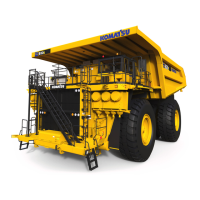Safety - Section 20 7/11 OM2042
Page 20-14
WHEN REPAIRS ARE NECESSARY
NOTE: Only qualified maintenance personnel who
understand the systems being repaired should
attempt repairs.
• Many components on the Komatsu truck are
large and heavy. Ensure that lifting equipment -
hoists, slings, chains, and lifting eyes - are of
adequate capacity to handle the lift.
• Do not work under a suspended load. Do not
work under a raised body unless body safety
cables, props or pins are in place to hold the
body in up position.
• Do not repair or service the truck while the engine
is running, except when adjustments can only be
made under such conditions. Keep a safe
distance from moving parts.
• When servicing any air conditioning system with
refrigerant, wear a face shield and cold resistant
gloves for protection against freezing. Follow all
current regulations for handling and recycling
refrigerants.
• Follow package directions carefully when using
cleaning solvents.
• If an auxiliary battery assist is needed, first use
one cable to connect the 24V positive (+) post of
the disabled truck batteries to the 24V positive
(+) post of the auxiliary assist. Use a second
cable to connect the 24V negative (-) post of the
auxiliary assist battery to a frame ground (-) on
the disabled truck away from the battery.
• Always disconnect the positive and negative
battery cables of the vehicle before doing any
welding on the unit. Failure to do so may
seriously damage the battery and electrical
equipment. Disconnect the battery charging
alternator lead wire and isolate the electronic
control components before making welding
repairs. (It is not necessary to disconnect or
remove any control circuit cards on electric drive
dump trucks or any of the AID circuit control
cards.)
• Always fasten the welding machine ground (-)
lead to the piece being welded. The grounding
clamp must be attached as near as possible to
the weld area. Never allow welding current to
pass through ball bearings, roller bearings,
suspensions or hydraulic cylinders. Always avoid
laying welding cables over or near the vehicle
electrical harnesses. Welding voltage could be
induced into the electrical harness and possibly
cause damage to components.
• If the truck must be towed, use a rigid tow bar.
Check the truck frame for a decal recommending
special towing precautions. Also refer to
Operating Instructions - Section 30, Towing.
• Drain, clean, and ventilate fuel tanks and
hydraulic tanks before making any welding
repairs.
Any operating fluid, such as hydraulic oil,
escaping under pressure can have sufficient
force to enter a person's body by penetrating the
skin. Serious injury and possibly death may
result if proper medical treatment by a physician
familiar with this injury is not received
immediately.
• Relieve pressure in lines or hoses before making
any disconnects.
• After adjustments or repairs, replace all shields,
screens and clamps.
• Only a qualified operator or maintenance
personnel who are also qualified in truck
operation should move the truck under its own
power in the repair facility or during road testing
after repairs are complete.

